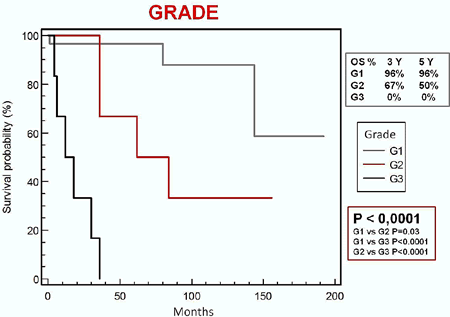ICEECE2012 Poster Presentations Neuroendocrinology (83 abstracts)
Ten years of gastroenteropancreatic neuroendocrine tumours: evolution of the classification and correlation with follow-up in 50 patients
M. Albertelli , F. Grillo , A. Giannone , L. Mastracci , F. Annunziata , M. Arvigo , F. Minuto , R. Fiocca & D. Ferone
University of Genova and IRCCS Azienda Ospedaliera Universitaria San Martino - IST - Istituto Nazionale per la Ricerca sul Cancro, Genova, Italy.
Gastroenteropancreatic (GEP) neuroendocrine tumours (NETs) are rare neoplasms with heterogeneous clinical behavior and potential long-term survival. In the last decade GEP–NET nomenclature has been twice reviewed. However, the 2000 WHO classification had poor prognostic power in well differentiated (WD) neoplasms. This led to the introduction of two new important parameters by the European Neuroendocrine Tumors Society (ENETS), grade and stage; the former became part of the new 2010 WHO classification. Considering the recent introduction of grade and stage, their external validation has been strongly requested.
Since these are important tools in the management of patients with NETs, our aim was to reclassify retrospectively, with grade and stage, our series and correlate with follow-up results.
From the histopathology archive at our centre, 170 GEP–NETs (1993–2011) were identified. Only 50 patients have been reclassified so far and the work is still in progress. Mean age at diagnosis was 56 years, F:M ratio was 1:1.2 and mean follow-up was 56 months (2–196).
Correlating differentiation with overall survival (OS), WD NETs had strikingly better outcome with respect to poorly differentiated ones. However only grade identified a subgroup of patients with WD lesions with less favorable clinical behavior (OS at 5 years: G1–96% vs G2–50%). Stage was also useful, though not statistically significant in our series so far.
Our data confirm the importance of grade and stage in prognostic stratification. Indeed, the new 2010 WHO classification has a better prognostic power and better predict the clinical course of WD disease. Therefore, in view of the long survival of patients with NETs, the retrospective classification of patients who may not have been previously graded or staged, may influence the choice of therapeutic options, especially in the future.

Overall survival of GEP NETs stratified according to the grading.
Declaration of interest: The authors declare that there is no conflict of interest that could be perceived as prejudicing the impartiality of the research project.
Funding: This research did not receive any specific grant from any funding agency in the public, commercial or not-for-profit sector.
 }
}



